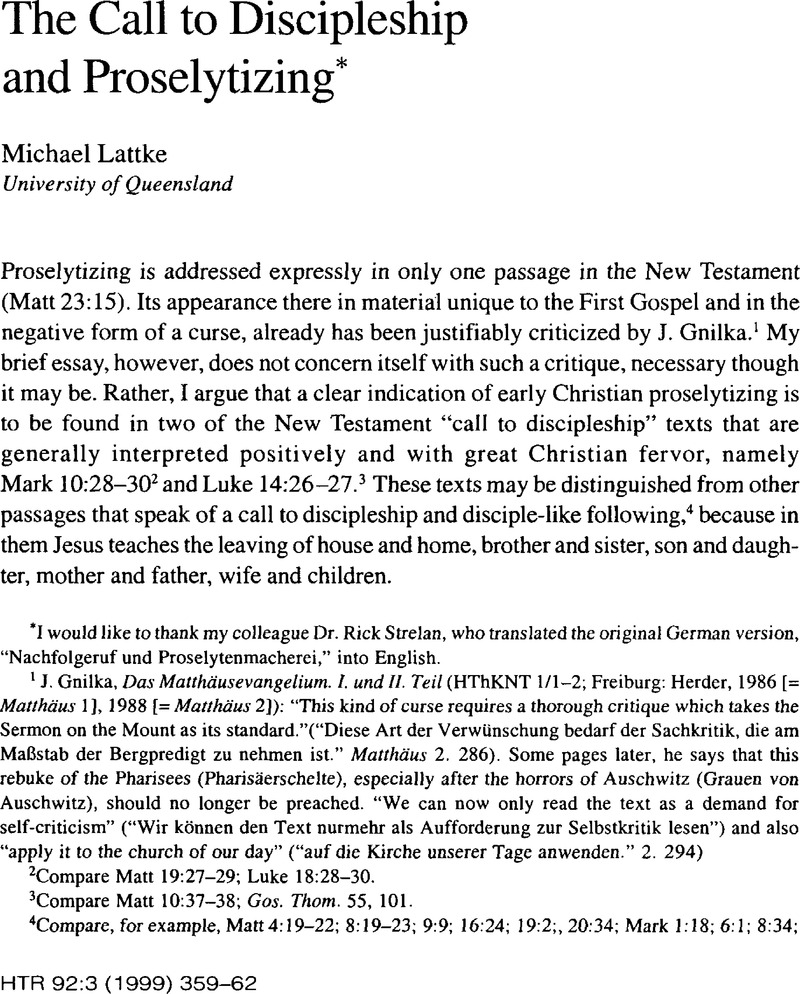No CrossRef data available.
Article contents
The Call to Discipleship and Proselytizing*
Published online by Cambridge University Press: 10 June 2011
Abstract

- Type
- Notes and Observations
- Information
- Copyright
- Copyright © President and Fellows of Harvard College 1999
References
1 Gnilka, J., Das Matthäusevangelium. I. und II. Teil (HThKNT 1/1–2; Freiburg: Herder, 1986Google Scholar [= Matthäus 1], 1988 [= Matthäus 2]): “This kind of curse requires a thorough critique which takes the Sermon on the Mount as its standard.” (“Diese Art der Verwünschung bedarf der Sachkritik, die am MaBstab der Bergpredigt zu nehmen ist.” Matthäus 2. 286). Some pages later, he says that this rebuke of the Pharisees (Pharisäerschelte), especially after the horrors of Auschwitz (Grauen von Auschwitz), should no longer be preached. “We can now only read the text as a demand for self-criticism” (“Wir können den Text nurmehr als Aufforderung zur Selbstkritik lesen”) and also “apply it to the church of our day” (“auf die Kirche unserer Tage anwenden.” 2. 294)
2 Compare Matt 19:27-29; Luke 18:28-30.
3 Compare Matt 10:37-38; Gos. Thom. 55, 101.
4 Compare, for example, Matt 4:19-22; 8:19-23; 9:9; 16:24; 19:2;, 20:34; Mark 1:18; 6:1; 8:34; 10:21; 10:52; Luke 5:11; 5:27-28; 9:23; 9:57; 9:59; 9:61; 18:22; and John 1:43; 8:12; 12:26; 13:36-37; 21:19-22. These passages have been abundantly discussed, chiefly in term of cross-bearing discipleship and the authority of Jesus. However, not even the extensive studies of Bammel, E. in Jesu Nachfolger: Nachfolgeüberlieferungen in der Zeit desfriihen Christentums (Studia Delitzschiana, 3d Folge, vol.1; Heidelberg: L. Schneider, 1988),Google Scholar address the connection between discipleship and proselytization. That Jesus called his own disciples, and gathered around him his own students, can hardly be doubted (compare Lattke, Michael, “Neue Aspekte der Frage nach dem historischen Jesus,” Kairos 21 [1979] 288–99, esp. 299)Google Scholar.
5 Compare Kuhn, K. G., “προσλυѕ,” TDNT 6 (1968) 727–44,Google Scholar esp. 732 (reference to De Somniis 2. 273, does not add a new aspect); Kuhli, H., “προσλυτοѕ,” EWNT 3 (1983) 410–13,Google Scholar esp. 412 (“Philo kennt das Wort π. eindeutig als t.t.”); Levinskaya, I., The Book ofActs in Its Diaspora Setting, in Winter, B. W., ed., The Book of Acts in Its First Century Setting (5 vols.; Grand Rapids: Eerdmans, 1996) 5. 36-49Google Scholar.
6 Compare Kittel, G., “ảκολουθω κτλ,” TDNT 1 (1964) 210–15;Google ScholarSchneider, G., “κολουθω κτλ.,” EWNT 1 (1980) 117–25Google Scholar.
7 Gnilka, J., Das Evangelium nach Markus, 2. Teilband: Mk 8, 27-16, 20 (EKK 2/2; Zürich et al.: Benziger/Neukirchen-Vluyn: Neukirchener Verlag, 1979) 92:Google Scholar “Philo kommt unserer Stelle besonders nahe: ‘Diese haben Kinder, Eltern und Geschwister, Nachbarschaft und Freundschaft hinter sich gelassen, um an Stelle des irdischen das ewige Erbe zu finden’ (SacrAC 129).” The relevant Greek words are τκυα, γονεîs, ảδελΦοúѕ, rand тà oỉκειóτατα καìΦíτατα. Compare Cohn, L., ed., Philonis Alexandrini opera quae supersunt (8 vols.; 1962; reprinted Berlin: de Gruyter, 1986) 1. 254Google Scholar.
8 Sacr. AC 128. Compare , Cohn et al., eds., Philo von Alexandria: Die Werke in deutscher Übersetzung (6 vols.; Berlin: de Gruyter, 1962) 3. 261Google Scholar (see “Leviten,” “Fliichtlinge”).
9 Compare , Cohn, Philonis Alexandrini (1906; reprinted 1962) 5. 12–13;Google Scholar, Cohn, Werke, 2425;Google ScholarColson, F. H., Philo (1937; LCL; 10 vols.; reprinted Cambridge, MA: Harvard University Press, 1984) 7. 126-29Google Scholar.
10 προσεληθέναι καινῇ καί Φιλοθέῳ πολιτείᾳ (Spec. leg. 1.51).
11 Compare also Lev 24:22.
12 Spec. leg. 51-52.
13 , Gnilka, Matthäus 2. 286Google Scholar (“Ubernahme der Beschneidung und des ganzen Gesetzes”). “Daneben gab es die Halbproselyten Oder Gottesfürchtigen mit eingeschränkten Rechten und Pflichten.” There is no reason to assume that Philo does not speak of “Ganzproselyten.”
14 Schnelle, U., Einleitung in das Neue Testament (UTB 1930; reprinted Göttingen: Vandenhoeck & Ruprecht, 1994) 238.Google Scholar
15 Compare in Mark: ![]() , in Matt:
, in Matt: ![]() ; in Luke: τὰ ἲδια,
; in Luke: τὰ ἲδια, ![]() .
.
16 Compare in Mark:
17 Mark: ἔνεκεν έμοū καì ἒνεκεν τοũ εủαΥΥελíου. Matt: ἒνεκεν τοû ỏνματóς μου Luke: ἒεκεν τῇs βασιλεíαѕ τοû θεοû.
18 Mark: αøτκαμεν παντα και νκολονøνκαμεν οοι: Matt: αøνκαμεν παντα και ηκολονøηοαμεν οο; Luke: αøεντεσ τα ισια ηκολονøνοημεν οοι.
19 Luke 14:26-27 = Matt 10:37-38.
20 According to Koester, Helmut, “the Greek version of this gospel was used in Egypt as early as the second century” (Robinson, J. M., ed., The Nag Hammadi Library in English, 3d. [Leiden: Brill, 1988] 124).Google Scholar Compare pp. 132, 137 for an English translation by T. O. Lambdin of sayings 55 and 101.


